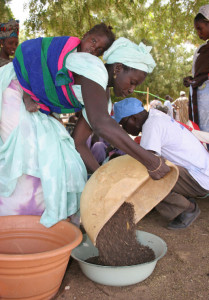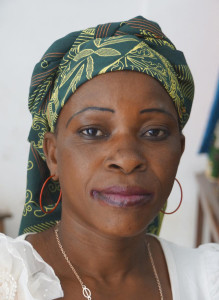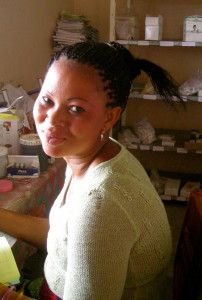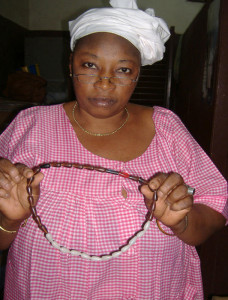An “audience” is a group on whom SBCC efforts will focus. When you think of all the people you want to reach with your SBCC program, they fall into two groups: primary and influencing audiences. It is important to identify who you will be reaching in order to target your message to that individual. Your research findings should help you determine who your audiences should be.
Primary audiences are the key people to reach with messages, often because they are directly affected, directly involved or are the decision-makers for those who would benefit from a call to action.
Influencing audiences are those who can affect how primary audiences think about the specific behavior, shape social norms, influence policies or impact knowledge and behavior, either directly or indirectly.
Audiences may be segmented by demographic characteristics (such as sex, age, marital status, educational level, socioeconomic status, employment and/or residence) or by psychographic factors (such as values, opinions, attitudes or other lifestyle factors). For FP and MCH programs, audiences usually include women and couples of reproductive age (15 to 49 years), health facility staff or community distributors who provide FP or MCH services, and other community members and leaders who can influence behaviors, social norms and policy. As shown in the profiles, women might be just AMA, just HP, or both AMA and HP at once. It is important to acknowledge these differences so that program efforts reach women of various ages and parities and life stages as each of these groups may have different needs and circumstances. Postpartum and pregnant women are important sub-groups of all segments and might benefit from interventions tailored specifically to them.
Here are sample primary and influencing audience profiles for AMA- and HP-pregnancy prevention programming, including a few considerations.
Primary Audiences
Primary Audience 1: Women, 35 years old, who have already had five births
(AMA and HP, including postpartum and pregnant women)
 Photo Credit: © Shehu Danlami Salihu, courtesy of Photoshare |
Audience Profile: Zalia is 35 years old and is the mother of five children. She is semi-literate and works as a fruit seller in small rural village. The nearest health center is five kilometers away and Zalia would go but it costs her CFA 600 for public transportation each way, besides the difficulty leaving her stall in the market. She is currently pregnant but does not want any more children after this one. She has never used family planning, but she’s heard of the pill and condoms. She has never discussed family planning with her husband and is afraid to bring it up. Zalia and her husband are part of a very large extended family where decisions are made collectively, and she does not feel that she can make this decision on her own. Consideration: Women who are in their mid-30s and women anticipating the birth of a fifth or higher child are the most at risk for future AMA and HP pregnancies if they continue to have children. You should consider your audience’s specific life stage and AMA/HP pregnancy risk level carefully when designing program messages and activities to make sure that your program will truly have its intended impact. |
Primary Audience 2: Women, less than 35 years old, anticipating a fifth pregnancy
(HP but not AMA)
 Photo credit: © 2006 Richard Nyberg, courtesy of Photoshare
|
Audience Profile: Mary is 28 years old and has four children. She grows vegetables and has a few small animals. She and her husband have never been to school and she does not know how to read. Her husband has a radio and they often listen for advice on crops and prices. During her last pregnancy she experienced maternal hypertension and knows that getting pregnant again might be dangerous for her. She is afraid to bring up birth spacing or limiting with her husband for fear he may look for another wife. Consideration: Education levels and cultural norms, such as polygamy and religion, heavily impact how and whether a woman uses FP, and whether her husband supports this decision. Design program efforts based on the local reality, and make sure these details come through in your audience profile. |
Primary Audience 3: Women, 35 years or older, who have not yet had five births
(AMA but not HP)
 Photo Credit: © 2015 Arturo Sanabria, Courtesy of Photoshare |
Audience Profile: Florence is 37 years old, has a secondary school education and runs her own small shop in town selling food and household goods. She has three daughters. Florence and her husband do not particularly want more children, and Florence has used injectable contraceptives successfully since her last daughter’s birth. However, recently she has felt pressure from her mother-in-law to have another child – to try for a son. Florence can tell her husband is softening to the idea, too. Florence has heard having a child at her age can be dangerous, and worries about providing for another child. But her husband’s family is more traditional. They think a woman can easily continue to have children until menopause, and that a large family shows wealth and good fortune. She worries that if she loses her husband’s support to use FP, she will be forced to have another child. Consideration: AMA women can feel pressure to have more children and programs need to provide additional support to ensure that she has a healthy pregnancy or consider reaching influencing audiences with messages to reduce making demands on AMA women to have more children. |
Primary Audience 4: Women, less than 35 years old, who have not had five births
(not yet AMA or HP)
 Photo Credit: © 2010 Erika Lobe, Courtesy of Photoshare |
Audience Profile: Beatrice is 24 years old and studying to be a pharmacist. She and her husband have agreed to delay starting their family until Beatrice has finished school and worked for a few years. They know that they want to have four children. They are satisfied users of modern family planning but have not really thought about how they will space their children once they start their family or how old Beatrice wants to be when she has her last child. Consideration: Particularly in urban areas, women are delaying starting a family so they can reach personal, career or education goals before having a child. Younger women should be encouraged to think early on about how they will time and space their pregnancies in order to minimize especially AMA risks to themselves and their children. |
Primary Audience 5: Providers of FP services
 Photo credit: © 2008 Rachel Hoy, Courtesy of Photoshare |
Provider Profile: Habiba is an older midwife who is well respected in her community, and is a real resource for the women in her community who need her care during childbirth. Men and women alike respect Habiba’s importance in obtaining successful birth outcomes. Habiba has the same values as her community and has not entirely accepted that AMA and HP women need modern FP. Because her community believes in her, she sometimes does not admit to gaps in knowledge about FP methods, their effectiveness and the manageability of FP methods’ side effects. Consideration: Communities need clinical and non-clinical providers to help women and couples to successfully begin and continue to use FP methods to prevent AMA and HP pregnancies. Providers may be at risk of AMA or HP themselves and not aware of the consequences. Providers need to be trained to counsel couples on the risks of AMA and HP pregnancies, assist them in finding the FP method that is right for them, and provide advice and guidance if needs change or side effects occur, regardless of their personal beliefs. |
Influencing Audiences
Influencing audiences for FP and MCH programs focused on AMA and HP pregnancies could include:
- Male partners of women at or approaching HP or AMA – A major barrier to FP use is women assuming their partners are against it. Messages directed at male partners encouraging them to discuss FP with their wives/partners, including the risks of AMA and HP pregnancies, and support their wife’s FP choices will influence women’s use and continuation of FP.
- Friends and neighbors – Peers provide a support network on which many women rely for advice and information. Women who are satisfied users of FP are also valuable for referring their friends to services.
- Community and religious leaders – Leaders have a great influence over FP decision-making. Especially as it relates to religion, it is important to make clear that Islam and Christianity support FP.
- Journalists – Where literacy levels are low, radio especially is one of the most used sources for news and information, including health information. As important information sources, radio and other media (e.g., TV, print) journalists producing stories on the benefits of FP for preventing AMA and FP pregnancies can encourage dialogue between couples and promote use of FP and MCH services.
Programs should be sure to develop profiles for influencing audiences they decide to address, similar to the profiles for primary audiences. These will help guide program planning and message development.


No Comments